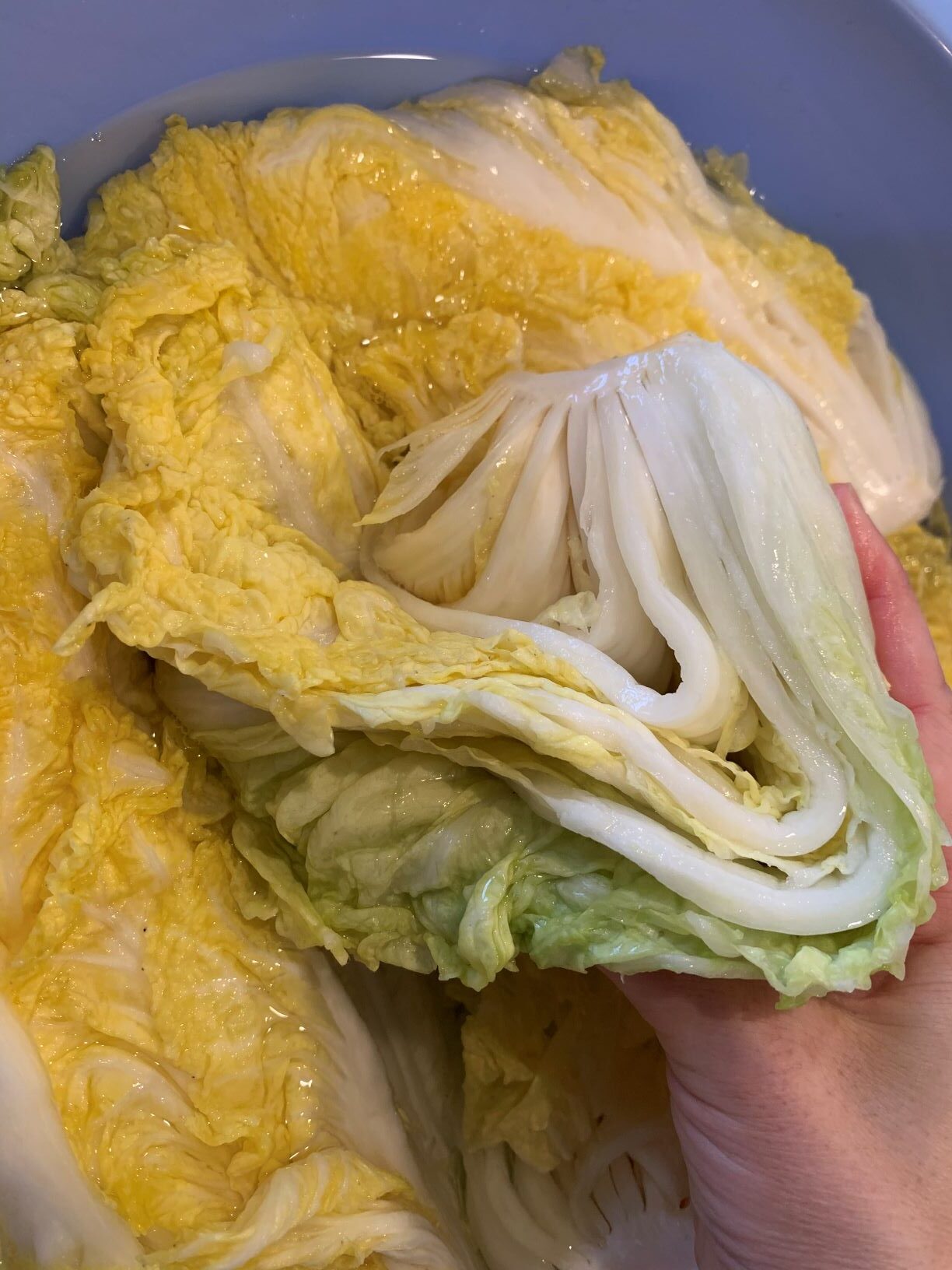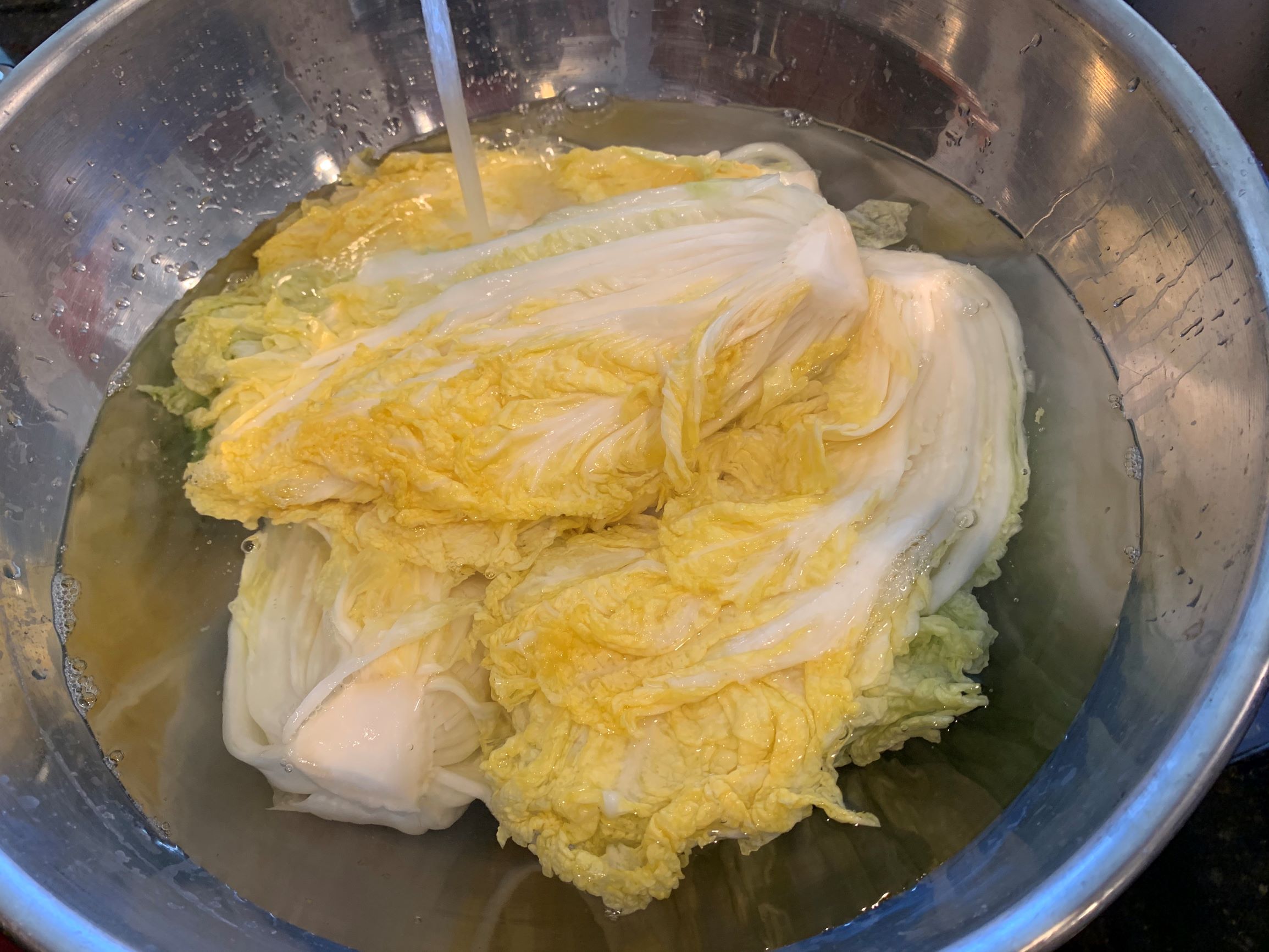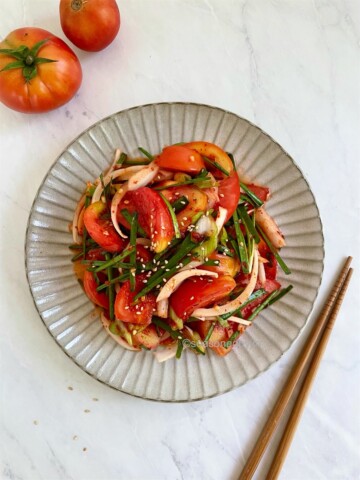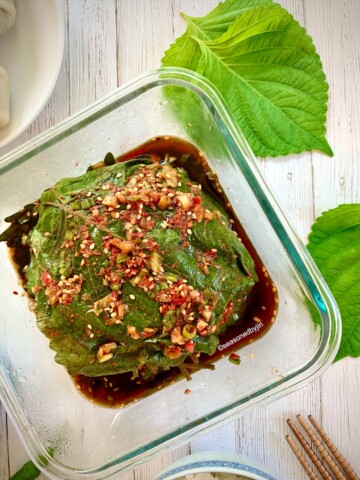Korea’s number one food–Kimchi– has finally become a favorite side dish for many households around the world. I find it interesting that we all talk about kimchi, but not much about “How to brine a Napa Cabbage for Kimchi” So I decided to write about it. In this post, I will share with you how to successfully brine your cabbage and other vegetables. Remember, you are Just one step closer to making your delicious kimchi!
why did i get into the brining topic?
There is never going to be a perfectly brined kimchi, but why not get close to it. I myself was never taught how to make or brine a kimchi! (And yes I am 100% Korean!) So when I first got into kimchi making from home, I was lost! Many recipes were very vague about the measurements and didn’t quite have detailed explanation on how to brine a napa cabbage. I was very disappointed and ended doing a lot of research and pretty much did multiple trials and errors in my own kitchen to find out the answers.


What is brining?
Brining is when you treat food with salt or when you soak food into a salty water solution. This process is important in Kimchi making because it helps the vegetables to draw out water, allowing it to become tender and pliable. In return, helps the seasonings/flavors to absorb evenly over time. Brining is essential in Kimchi preservation and fermentation.
dry brine vs. wet brine for Kimchi:
Did you know there were different types of brining for kimchi? Dry brine is when you sprinkle the cabbage with salt and is left sitting for certain amount of time and then the salt is rinsed off. Wet brine is when the cabbage is soaked in salt water for certain amount of time and then the salt is rinsed off. For most Koreans, the combination of dry brine and wet brine is used for making cabbage kimchi.
how to cut a whole napa cabbage:






- Peel away any outer layers that have been damaged or discolored. If you leave them in your kimchi, they will taste bitter. You can wash these and use them later for stews or soups.
- Trim off the cabbage tip as needed.
- Slice the cabbage down the middle, through the stem, about half lengthwise.
- Next, pull apart the cabbage with hands in opposite directions, leaving you with two equal parts.
- Repeat and slice the cabbage halfway down the center then pull apart with hands.
- You should have four equal cabbage parts at this point.
This is a very useful way to cut/trim a napa cabbage for making your kimchi. You will end up with less mess and less waste. Trust me, I have cut through the middle before and ended having a huge mess in my kitchen!
What kind of salt is best for kimchi brining?
Please look for a coarse sea salt at the Asian Market. The texture is very coarse as you can see in the photo. This salt unfortunately can not be used in cooking, but for brining only. They taste salty but doesn’t have a bitter aftertaste. Do try to look for the Natural Sea Salt.


what kithchen essentials do i need for brining?
You will need at least 2 big bowls. I have an orange one and a blue one pictured. I will use the blue bowl to dissolve the salt and water, then the cabbage will take a quick bath in it. You can also have a 1 cup size measuring cup handy to help pour the water onto the cabbage. After the bath time, cabbage will be taken to the orange colored bowl to get sprinkled with salt, and remain in that bowl for a long time. You will also need one big strainer, mine is white colored in the photo. Lastly one little bowl to store your sea salt. I used a metal bowl. Again, my pictures are showing details for brining only one cabbage, imagine if I had to brine the whole box of cabbages! Yikes!


how to brine a napa cabbage!
Reminder: These steps and measurements are based on one cabbage only!! (5lbs)






Step 1: Pour 6 cup of water into a large bowl and add 3/4 cup of salt. Stir well with hand until well dissolved.
Step 2: Place the cabbage into the salty water. Scoop & pour water onto the cabbage, about 7-8x. (I used my measuring cup to help.) I call this the bathing phase.
Step 3: Raise the cabbage up from the bowl and let the water drip for about 7-8 seconds.
Step 4: Place the bathed cabbage into another big bowl to get salted. Starting from the outside cabbage layer first. start sprinkling the salt. I recommend grabbing a pinch of salt and do like a tossing action into the core, (white part of cabbage) and another pinch of salt to sprinkle for the green leafy part. Repeat until all the leaves have been sprinkled with salt. Your goal is to use all of the 1/2 cup of salt for 4 quartered cabbages = 1 whole napa cabbage.
Step 5: Pour the salt water, that was used to bathe, evenly on top of the salted cabbages.
Step 6: Make sure all the cabbage cores are facing upward. Wrap the bowl in Seran Wrap. Let it sit in room temperature for 6-8 hours. When the room temperature is warmer, the brine phase takes less time. But when the room temperature is colder, brining can take longer. **Important Tip!! Please don’t forget to rotate the cabbages every few hours. So the bottom pieces will come up and the top pieces will go to the bottom, and vice versa.
how to brine Korean radish
If you plan to add big radish chunks into your kimchi, that is a very wise choice! I think it really heightens the overall flavor!! After you peel and chop the radishes into big chunks, you want to throw them into the kimchi brine bowl. They don’t need to be submerged completely. They just need to sit in salt water for one hour. and then rinse. If you leave it too long, the radish will be too salty! A reminder, no more than an hour for brining!! The julienned radish does not need to be brined. They can be mixed into the kimchi seasoning.


how do you know when brining is complete?
Before brining, the cabbage leaves will feel thick and stiff and display an opaque color. But after brining, the leaves will feel soft, bendable and the color will be more transparent. The brining time will vary depending on the thickness of the leaves and the room temperature.



How many times should I rinse the cabbage?
Since the cabbages have been brined for a long time, 6-8 hours in salt water, it will be really salty to taste. I always rinse mine 3x in cold water and that has worked pretty well. Don’t just swoosh, rub the inner core area of the leaf. (the attached part) Trust me, this phase is important. Otherwise, your kimchi can become too salty to eat!! I have learned from my mistakes!!
After rinsing, squeeze the cabbage gently to get rid of water. Have the core side down on the strainer and keep it there for about 30min to 1 hour.




Congratulation!! You have completed the brining phase!! your cabbage is ready for kimchi seasoning!!
I hope you have found this post useful in one way or another! You are ready to add the seasoning into your kimchi! Now the fun begins!
my TAKEAWAY from the brining experiments:
- You will never have a perfectly brined cabbage. Meaning there are too many variables for brining. The temperature in the room, the time factor, the width and depth of your bowls, the type of salt, and the size of the cabbage.
- It is okay to over brine the cabbages. The cabbages may be saltier than expected. Make sure to rinse with water a couple more times and if that doesn’t help, you can soak it in cold water for 10-20 mins until desired saltiness.
- If you under brine the cabbages, it’s ok too. They may not be as salty and do not need as much rinsing in cold water. The cabbage leaf texture will be firmer and thicker. Just remember this cabbage will release more water during the fermentation process.
how do you know if you had a successful brining?
If you had a successful bringing phase, your kimchi will stay crunchy and fresher longer. It will also help in bringing out the cabbage flavors to the fullest even before adding the kimchi sauce.
what if something goes wrong during brining?
As long as there isn’t a strange odor or a big change in texture, let’s say soft and mushy, your cabbage should be fine. There is a possibility if the room temperature is way too hot and humid., the cabbage may not brine correctly. Do not continue if this happens since the cabbages may have become spoiled.
did you enjoy this post?
So here it is guys, I hope that through this page, many others will benefit from it and be able to brine a whole napa cabbage successfully!! I do have a list of delicious Kimchi recipes, please see below! Happy Kimchi making!!
what’s to come ahead:
I plan to write a future post on how to brine the cut cabbages, which are used to make quick kimchi or Mak Kimchi. This particular brining post was specifically written for a kimchi called Pogi kimchi, which is for making the whole napa cabbage kimchi.
How to Brine a Whole Napa Cabbage for Kimchi
Ingredients
- 1 whole Napa cabbage 5 lbs
- 6 cup filtered water
- ¾ cup coarse sea salt brining
- ½ cup coarse sea salt sprinkle
- ½ lb Korean radish (peeled and chopped into big chunks) optional
Instructions
- Pull away any outer layers of cabbage that have been damaged or discolored and trim off the cabbage tip as needed.
- Slice the cabbage through the stem, about half lengthwise. Carefully pull apart the cabbage in half.
- Repeat and slice the halved cabbage through the stem, and pull apart. There should be 4 equal cabbage parts at this point. Set aside.
- Pour 6 cups of water into a big bowl and add 3/4 cup of sea salt. Stir well to dissolve.
- Place each quartered cabbage into the salty water and give it a nice bath by pouring water onto each cabbage. Scoop and Pour water onto the cabbage, repeat 7-8x.
- Take the bathed cabbage into another big bowl and sprinkle with sea salt. Starting from the outer layer first. Making sure each leaf gets sprinkled with salt, with careful attention to the core area (the white part). Repeat the bathing and salt sprinkle process to all 4 quartered cabbages, using up 1/2 cup of sea salt completely.
- Pour the salty (bathed) water evenly on top of the salted cabbages. Press the cabbages down gently, making sure the cores are facing up. Wrap with Seran Wrap and set your timer.
- Let the cabbages sit in the bowl for about 6-8 hours. Rotate the cabbages every few hours. Making sure to bring the bottom cabbages to the top, and top cabbages to the bottom, and vise versa. (Optional: If brining the big radish chunks, toss them into the same bowl with the cabbages and let it sit for 1 hour, then rinse and set aside)
- Check for the physical changes in the cabbage. If they are bendable, flexible and more transparent in color, they are ready to get rinsed!! Rinse in color water at least 3x. Making sure the core (white part) gets good rubbing with your hand. Squeeze excess water gently.
- Place the cabbages, with core side facing down, on the strainer for 30min-1hour. The cabbages are ready to get seasoned!! Yay!!
This post was updated 8/8/2022












John
Thank you
Mike
Can you simply prep the Napa Cabbage by chopping it into 1 to 2 inch pieces, then soak/brine for 5 hours and rinse really well to eliminate the excess salt? I want to make Kimchi in 2 quart mason jars while the produce is in season here in Michigan.
seasonedbyjin
Yes you can chop the napa cabbage into smaller pieces and brine them. However, the brining time needs to be adjusted. Around 2 hours will be good, but in the warmer months, it may take 1 1/2 hour.
The biggest reason why certain people like whole napa kimchi vs the chopped version is due to the final taste and texture. If you have time, try both versions and you can see the difference. Hope that helps!
Mentari
Hello!
I live in a tropical island, so I am wondering, do I need 6-8 hours brining the kimchi?
My first trial with kimchi, I brined less than 6 hours, it tasted good, sweet and crunchy.
Second trial, I brined 8 hours and it turned sour and less crunchy.
Is there a difference between brining for short amount of time and longer amount of time…?
Thank you so much 🙂
seasonedbyjin
Hi there, I live in a 4 season climate, is your area very hot and humid? I did notice that in the warmer months, the cabbage wilted much faster. I did over brine a few times and that made the cabbage more salty and much more wilted texture but not sour. It would turn sour from fermentation not from brining. If the shorter brining time works for you, I say go for it! What’s your typical kitchen temperature? My home is 70 degrees F.H. all year around. I am wondering if your cabbage turned sour from the warm room temperature perhaps?